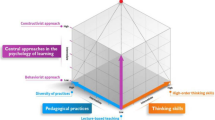Abstract
Conscious of the interplay between nature and nurture in determining a child’s individuality and success in life, the author embarked a group of teachers in an action research project towards nurturing a culture of thinking in young children. Considering the positive effects of routines in early learning experiences, the research consisted in implementing thinking routines to engage young children’s minds in thinking activities. The study took place in two Reggio-inspired schools where participating teachers documented children’s work as part of their teaching. The documentation was a key element to make children’s thinking visible as they installed the culture and language of thinking in their classrooms. The study found that thinking routines build up positive attitudes about thinking and learning. By re-visiting their documented work children developed metacognitive and critical thinking skills which make them more alert to situations that call for thinking.



Similar content being viewed by others
References
Bredekamp S., & Copple C. (Eds.) (1997). Developmentally appropriate practice in early childhood programs. Revised Edition. Washington, DC: NAEYC.
Hendricks, C. (2006). Improving schools through action research: A comprehensive guide for educators. Boston: Pearson Allyn & Bacon.
Katz, L. G., & Chard, S. C. (2000). Engaging children’s minds: The project approach (2nd ed.). Norwood, NJ: Ablex Publishing.
Perkins, D. (2003). Making thinking visible. New horizons. Retrieved August 20, 2007 from http://www.newhorizons.org/strategies/thinking/perkins.htm.
President and Fellows of Harvard College (2006). Artful thinking: Stronger thinking and learning through the power of art. Retrieved July 15, 2007 from http://www.pz.harvard.edu/Research/ArtfulThinkingFinalReport.pdf.
Project Zero (2007). Visible thinking. Retrieved August 20, 2007 http://www.pz.harvard.edu/Research/ResearchVisible.htm.
Project Zero, & Reggio Children (2001). Making learning visible: Children as individual and group learners. Reggio Emilia, Italy: Reggio Children.
Reynolds, P. (2003). The dot. Cambridge, MA: Candlewic Press.
Rinaldi, C. (2006). In dialogue with Reggio Emilia: Listening, researching and learning. London: Routledge.
Ritchhart, R. (2002). Intellectual character: What it is, why it matters, and how to get it. San Francisco, CA: Jossey-Bass.
Ritchhart, R., & Perkins, D. N. (2004). Learning to think: The challenges of teaching thinking. In K. J. Holyoak, & R. G. Morrison (Eds.), Cambridge handbook of thinking and reasoning (pp. 1–31). Cambridge, MA: Cambridge University Press.
Ritchhart, R., Palmer, P., Church, M., & Tishman, S. (2006). Thinking Routines: Establishing Patterns of Thinking in the Classroom. Paper prepared for AERA Conference.
Seuss (1975). Oh, the thinks you can think. New York: Beginner Books A Division or Random House Inc.
Shonkoff, J., & Phillips, D. A. (Eds.) (2000). From neurons to neighborhoods: The science of early childhood development. Washington DC: National Academy Press.
Tishman, S., Perkins, D., & Jay, E. (1995). The thinking classroom: Learning and teaching in a culture of thinking. Boston: Allyn and Bacon.
Vygotsky, L. (1978). Mind in society. Cambridge, MA: Harvard University Press.
Author information
Authors and Affiliations
Corresponding author
Rights and permissions
About this article
Cite this article
Salmon, A.K. Promoting a Culture of Thinking in the Young Child. Early Childhood Educ J 35, 457–461 (2008). https://doi.org/10.1007/s10643-007-0227-y
Received:
Accepted:
Published:
Issue Date:
DOI: https://doi.org/10.1007/s10643-007-0227-y




